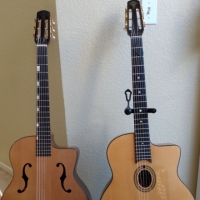DjangoBooks.com
Welcome to our Community!
Categories
- 20K All Categories
- 1.1K General
- 478 Welcome
- 59 Archtop Eddy's Corner
- 146 CD, DVD, and Concert Reviews
- 385 FAQ
- 26 Gypsy Jazz Italia
- 27 Photos
- 207 Gypsy Picking
- 21 Unaccompanied Django
- 15 Pearl Django Play-Along Vol.1
- 17 Gypsy Fire
- 45 Gypsy Rhythm
- 1.4K Gypsy Jazz University - Get Educated
- 131 Gypsy Jazz 101
- 228 Repertoire
- 224 History
- 708 Technique
- 51 Licks and Patterns
- 6 Daniel Givone Manouche Guitare Method Users Group
- 20 Eddie Lang Club
- 1.3K Gypsy Jazz Gear
- 805 Guitars, Strings, Picks, Amps, Pickups and Other Accessories
- 461 Classifieds
- 50 Recording
- 62 Other Instruments
- 18 Violin
- 5 Mandolin
- 22 Accordion
- 7 Bass
- 10 Woodwinds
- 348 Gypsy Jazz Events
- 143 North America
- 110 Europe
- 95 International









Comments
I'm not a "one true way" dogmatic type. To be clear, the "dead-end" comment is meant as purely physical. If I'm heading up the neck horizontally, the pinky seems to lock me into the position I'm in. For me it's good to use the pinky when changing directions, to reach out and grab a note before turning and heading back down the neck. Maybe I should have used the term "cul-de-sac" instead.
Another "cul-de-sac" situation.....Something I've been trying is to do away with barring two adjacent strings with one finger. Where before, I might have barred two notes with the ring finger in an arpeggio, I'll attempt one of those notes with the index and the other with the middle. It might seem clumsy, at first, but it sounds better to my ear as each note is staccato instead of one ringing. It also leaves me in a more balanced hand position to keep moving any direction I choose.
I hope that makes sense.
In the end, I'll continue to use the pinky and barres when absolutely necessary, but I've already starting to look at them as sometimes-necessary compromises when moving horizontally and I believe my playing to be improving quickly with this method. The goal is freedom of movement to result in freedom of expression.
I am turning my palm outwards to give my fingers more stretch where I used to have it parallel to the neck when playing "properly". At times, the first knuckle of my index is touching the bottom of the fretboard.
Another thought I had: for ascending dim7 arpeggios, the distance between frets gets smaller as you're going up the neck. So with 1 + 4 it may start out comfortable enough for the first 2 notes, but then as you ascend the crowding of fingers just keeps getting worse. Whereas, if you initially start out with 1 + 3 or 1 + 2, the stretch is getting less / easier as you ascend.
The pattern I've been practicing is that while descending, G string is one note per, and 2 notes per string ascending. Also while descending I'm using fingers 1 and 4 mostly and 1 and 3 while ascending.
It's a lot of writing to explain, it would be better and easier to make a video if need be.
If I correctly understand your question??
And yeah, I'm doing double down when going back up. Interestingly you mention "or some other trick". Because just yesterday I finally sat down to figure out Angelo's iconic intro to Swing Gitan, a bit of a milestone for me because when I was getting into playing this style in '04-5, I got a Birdland live DVD, and after watching that intro, I was thinking to myself "wow maybe one day I'll be able to play that".
Anyway, when he plays D7 arp going back up to conclude the whole thing, he's doing exactly that, plays extra stroke on the 7th so that he doesn't have to double down to wrap it up. Kinda surprised me because I thought his ability to play consecutive double down strokes is limitless but here he made his life simpler.